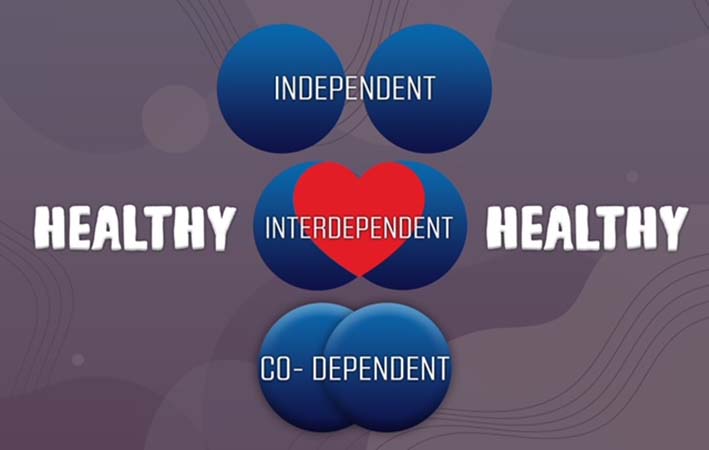Human beings are social creatures and relationships are an essential part of our lives. There are various types of relationships, each with its own characteristics and dynamics. We will discuss three main types of relationship dependency in this post: dependency, codependency, independency, and interdependency.
Dependent Relationships
Dependent relationships are characterized by one partner relying heavily on the other for emotional support, validation, and decision making. This type of relationship can stem from insecurity, anxiety, or a lack of self-confidence. It often leads to an unbalanced power dynamic. The dependent partner may often prioritize their partner’s needs over their own. They may struggle to make decisions or act without their partner’s input. This can create feelings of resentment and frustration for both partners, leading to a cycle of emotional dependency. Dependent relationships can be detrimental to both partners’ mental health and wellbeing. And they can lead to a lack of personal growth and development. It’s important for both partners to work towards a more interdependent relationship to foster a healthy, balanced partnership.
Codependent Relationships
Codependent relationships are characterized by one partner being overly reliant on the other. This type of relationship is often marked by an unhealthy cycle of enabling and dependence. The codependent partner may feel as though they need their partner to function or derive their self-worth from the relationship. This can lead to an unhealthy power dynamic, where the codependent partner sacrifices their own needs and desires to keep the relationship going. Codependent relationships are ultimately unhealthy because they can be emotionally draining for both partners, and can lead to feelings of resentment, anger, and frustration. The codependent partner may also struggle with their own sense of identity and self-worth outside of the relationship.
Independent Relationships
Independent relationships are characterized by each partner being self-sufficient and not relying on the other for validation or emotional support. This type of relationship allows each partner to pursue their own interests and hobbies, and to be comfortable spending time alone. While independence can be healthy in some cases, it can also lead to emotional distance between partners. An independent relationship may include a lack of intimacy and emotional connection. That’s because each partner prioritizes their individual needs over the needs of the relationship. While some degree of independence is important in any healthy relationship, it is important to strike a balance between individuality and togetherness to foster a deep, meaningful connection with your partner.
Interdependent Relationships
Interdependence is the healthiest type of relationship. Interdependent relationships are characterized by partners who rely on each other for emotional support and validation while also maintaining their individuality. In an interdependent relationship, both partners are committed to helping each other grow and develop, both as individuals and as a couple. This type of relationship encourages open and honest communication, empathy, and a willingness to compromise and collaborate. Interdependent partners are comfortable asking for help and support when they need it and are equally comfortable providing that help and support to their partner. By working together towards shared goals while also nurturing their individuality, interdependent partners build a strong, fulfilling relationship that brings out the best in each other.
The goal of relationship dependency
So how can we reach the healthiest type of relationship, which is interdependence? It starts with recognizing the patterns and dynamics in our current relationships. Are we overly reliant on our partners? Do we shy away from asking for help? Once we identify these patterns, we can work to change them. Communication is key in any relationship, and it is especially important in interdependent relationships. We must be open and honest with our partners about our needs and boundaries, as well as our goals and aspirations.
Another important aspect of interdependence is cultivating a sense of empathy and compassion for our partners. We must be willing to put ourselves in their shoes, to understand their perspective and experiences, and to be there for them when they need us. We must also be willing to let go of our own egos and work towards compromise and collaboration.
Review of relationship dependency styles
Relationships come in all shapes and sizes, and each type of relationship has its own strengths and weaknesses. Dependent relationships are characterized by one partner relying heavily on the other for emotional support and validation, often leading to an unbalanced power dynamic. Codependency can be draining and unhealthy, while independence can lead to emotional distance. Interdependence is the healthiest type of relationship, and it requires communication, empathy, and a willingness to compromise and collaborate. By recognizing the patterns and dynamics in our current relationships and working towards interdependence, we can build strong, fulfilling relationships that bring out the best in us and our partners.
About Therapist Bethany Winter, MA, LPC Barnum Counseling
Cooper, J. (2022, April 4). The 4 types of dependency in relationships. The Good Men Project. Retrieved March 30, 2023, from https://goodmenproject.com/featured-content/the-4-types-of-dependency-in-relationships/#:~:text=In%20this%20blog%20post%2C%20we,and%20work%20on%20overcoming%20them.
